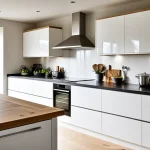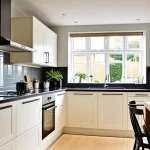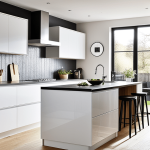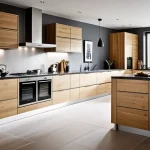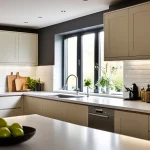Key Differences in Kitchen Layouts and Spatial Design
When comparing kitchen layouts across the UK and Europe, spatial design reflects notable regional distinctions. UK kitchens often face tighter space constraints due to older housing stock, which typically features smaller, compartmentalized rooms. This leads to more enclosed kitchen designs, prioritizing functionality within limited square footage. In contrast, European kitchens frequently embrace larger, open-plan configurations that promote fluidity between cooking and living areas.
A significant trend in European spatial design focuses on integration—blurring kitchen boundaries with dining and social spaces. This is less common in traditional UK homes, where kitchens often remain separate from main living areas. The preference for open-plan living in continental Europe supports informal interaction and multi-use spaces, an approach gaining gradual popularity in the UK but still less widespread.
In parallel : How are UK kitchens addressing the demand for personalized spaces?
Typical UK kitchen layouts prioritize efficiency in compact settings, using clever space-saving solutions such as corner units and vertical storage. Meanwhile, European counterparts, benefiting from larger footprints, accommodate islands or extended counters, enhancing both cooking functionality and social engagement. These differences underscore how historic housing patterns and lifestyle choices shape the spatial design and practical layout preferences seen across UK kitchens versus European kitchens.
Style, Aesthetics, and Material Choices
The style of UK kitchens often leans toward traditional designs, reflecting classic influences such as Georgian or Victorian motifs. In contrast, European design trends showcase broader diversity, including Scandinavian minimalism characterized by clean lines and light woods, German modernism with sleek, functional forms, and Italian flair emphasizing bold colours and artistic touches.
Have you seen this : How is technology transforming UK kitchen experiences?
Materials used in UK kitchens tend to favour durable, often heavier options such as solid wood cabinetry and granite worktops, suited to enduring style preferences. Meanwhile, kitchen layouts in European kitchens frequently incorporate lighter materials like laminate and engineered wood for cabinetry, combined with quartz or composite worktops that balance aesthetics with easy maintenance.
Colour palettes also differ notably. UK kitchens traditionally opt for muted, neutral tones — creams, soft greys, and pastels — which complement the existing architectural environment. European kitchens, by contrast, may embrace more vibrant hues or monochrome schemes, mirroring their emphasis on contemporary elegance and visual impact.
Flooring choices support these distinctions, with UK kitchens commonly featuring ceramic tiles or hardwood floors, while European kitchens sometimes use large format tiles or polished concrete, further enhancing the clean and spacious feel.
Together, these elements highlight the profound influence of regional culture and spatial design on kitchen styles and material choices.
Appliances and Kitchen Functionality
In comparing kitchen appliances between UK kitchens and European kitchens, a key distinction lies in appliance integration. European kitchens favour built-in appliances—dishwashers, ovens, and refrigerators neatly integrated to maintain sleek aesthetics and optimise space. UK kitchens show a stronger preference for freestanding appliances due to space constraints and traditional layouts, offering flexibility but sometimes sacrificing visual cohesion.
Innovations such as boiling-water taps, induction hobs, and advanced recycling solutions are increasingly common in European kitchens, reflecting a push for efficiency and sustainability. UK kitchens are gradually adopting these features but often at a slower pace due to existing infrastructure and cost considerations.
Regarding workflow, European kitchens typically prioritise ergonomic placement, with appliances and storage arranged to streamline meal preparation and social interaction in open-plan settings. UK kitchens, constrained by smaller, compartmentalised spaces, focus on optimizing storage and work surfaces for cooking efficiency.
Storage solutions in UK kitchens frequently include vertical units and corner cupboards to maximise limited space. European kitchens benefit from larger footprints allowing for kitchen islands or extended cabinetry, which enhances both practicality and social engagement. Overall, appliance choice and kitchen functionality in each region reflect differing spatial designs and lifestyle priorities.
Key Differences in Kitchen Layouts and Spatial Design
UK kitchens typically adapt to limited space by prioritising compact, efficient layouts. Because many UK homes feature older, compartmentalised housing stock, kitchens often measure smaller, necessitating clever use of vertical and corner storage, with spatial design focused on maximising every available inch. These layouts frequently retain separation from living or dining areas, reinforcing clearly divided functional zones.
In contrast, European kitchens generally benefit from larger footprints and open-plan designs. This approach encourages fluid interaction between kitchen, dining, and living spaces, reflecting a cultural emphasis on socialising and multifunctionality. European kitchen layouts often incorporate islands or peninsulas to foster communal cooking experiences and enhance workspace.
The spatial design of European kitchens also highlights flexibility, allowing for varied traffic flow and informal gatherings, which is less common in typical UK kitchen styles. While open-plan trends are emerging in the UK, traditional layouts still dominate due to structural and historical housing constraints.
Understanding these distinctions in kitchen layouts clarifies why UK kitchens often focus on practicality within confined spaces, while European kitchens prioritise openness, ergonomics, and social integration—each shaped by their respective architectural and cultural contexts.
Key Differences in Kitchen Layouts and Spatial Design
UK kitchens often contend with limited space, stemming from older housing stock. Typical kitchen layouts prioritize compactness, with smaller footprints compelling efficient arrangements. These kitchens commonly rely on vertical storage and corner units to maximise usability in cramped settings. Their spatial design focuses on segregating kitchen activities from living or dining areas, resulting in defined, compartmentalised rooms rather than open flows.
In contrast, European kitchens usually enjoy larger dimensions. Their kitchen layouts often embrace open-plan concepts, facilitating seamless transitions between cooking, dining, and socialising areas. This spatial design supports multifunctional use and encourages informal gatherings, accommodated by islands or peninsula counters that are uncommon in UK equivalents.
How does housing influence these differences? UK kitchens reflect the constraints imposed by terraced or semi-detached homes with smaller rooms, thus limiting spatial design options. European homes often feature more modern or purpose-built layouts allowing expansive kitchen spaces—promoting ergonomic workflow and community interaction.
Overall, while UK kitchens optimise functionality within confined spaces, European kitchens prioritise openness and social integration, shaped by their respective architectural heritage and lifestyle preferences.
Key Differences in Kitchen Layouts and Spatial Design
UK kitchens typically measure smaller than their European counterparts, influenced heavily by the country’s older housing stock. This spatial limitation drives kitchen layouts to be more compact and compartmentalised, focusing on utilising every inch through vertical storage and corner units. This approach maximises functionality within tighter quarters but often results in kitchens that remain distinct and separate from living or dining spaces.
Conversely, continental European kitchens benefit from generally larger footprints, enabling open-plan kitchen layouts that blur boundaries between cooking, dining, and social areas. Such spatial design fosters a more flexible, communal atmosphere, encouraged by kitchen islands or peninsula counters which support multifunctional use and informal gatherings.
The impact of differing housing types is crucial: UK homes often comprise terraced or semi-detached buildings with smaller, enclosed rooms restricting open-plan possibilities. On the other hand, many European residences incorporate modern or purpose-designed layouts granting expansive kitchens with fluid traffic flow.
These inherent contrasts in kitchen layouts, driven by available space and housing structure, create distinctive regional preferences. UK kitchens systematically prioritise compactness and separation, while European kitchens emphasise openness and integration within their spatial design frameworks.


